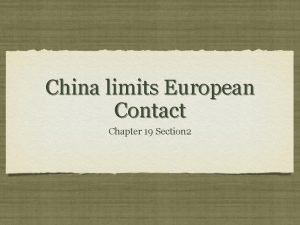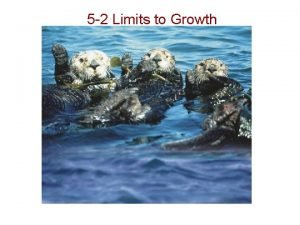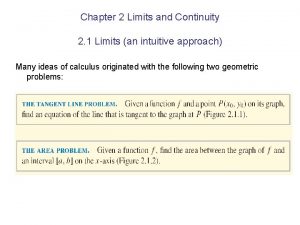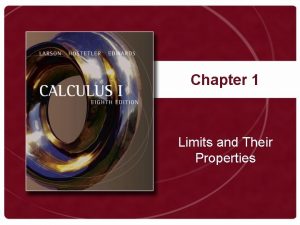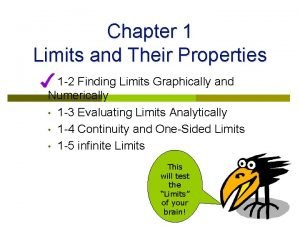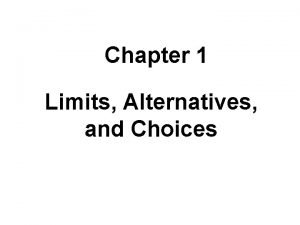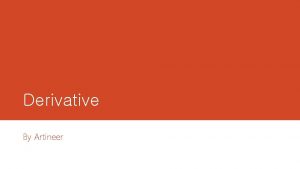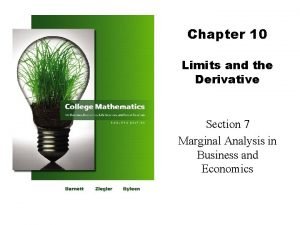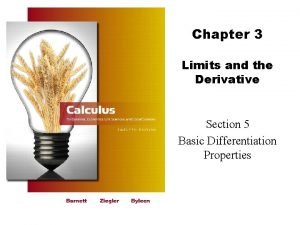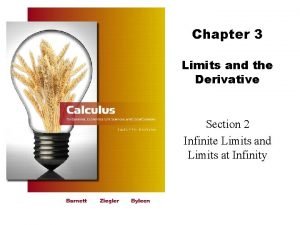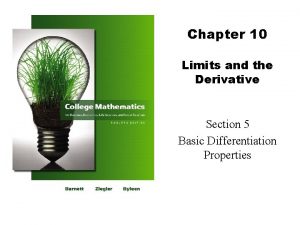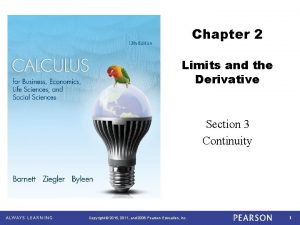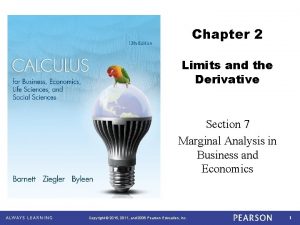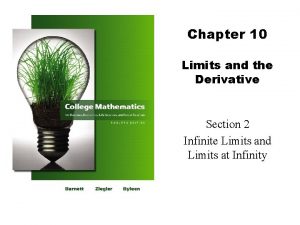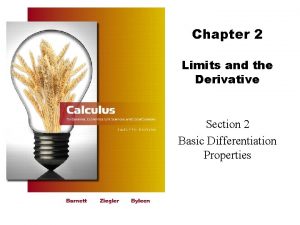Chapter 10 Limits and the Derivative Section R











- Slides: 11

Chapter 10 Limits and the Derivative Section R Review

Chapter 10 Review Important Terms, Symbols, Concepts § 10. 1. Introduction to Limits • The graph of the function y = f (x) is the graph of the set of all ordered pairs (x, f (x)). • The limit of the function y = f (x) as x approaches c is L, written as , if the functional value f (x) is close to the single real number L whenever x is close to, but not equal to, c (on either side of c). • The limit of the function y = f (x) as x approaches c from the left is K, written as , if f (x) is close to K whenever x is close to c, but to the left of c on the real number line. Barnett/Ziegler/Byleen College Mathematics 12 e 2

Chapter 10 Review § 10. 1. Introduction to Limits (continued) • The limit of the function y = f (x) as x approaches c from the right is L, written as , if f (x) is close to L whenever x is close to c, but to the right of c on the real number line. • Limit properties are useful for evaluating limits. • The limit of the difference quotient [ f (a+h) – f (a)]/h always results in a 0/0 indeterminate form. Algebraic simplification is required to evaluate this type of limit. Barnett/Ziegler/Byleen College Mathematics 12 e 3

Chapter 10 Review § 10. 2. Infinite Limits and Limits at Infinity • If f (x) increases or decreases without bound as x approaches a from one side of a, then the line x = a is a vertical asymptote for the graph of y = f (x). • If f (x) gets close to L as x increases without bound or decreases without bound, then L is called the limit of f at or -. Barnett/Ziegler/Byleen College Mathematics 12 e 4

Chapter 10 Review § 10. 2. Infinite Limits and Limits at Infinity (continued) • The behavior of a polynomial is described in terms of limits at infinity. • If f (x) approaches L as x or as x - , then the line y = L is a horizontal asymptote for the graph of y = f (x). Polynomial functions never have a horizontal asymptote. A rational function can have at most one horizontal asymptote. Barnett/Ziegler/Byleen College Mathematics 12 e 5

Chapter 10 Review § 10. 3. Continuity • Intuitively, the graph of a continuous function can be drawn without lifting a pen off the paper. Algebraically, a function f is continuous at c if 1. 2. f (c) exists 3. • Continuity properties are useful for determining where a function is continuous and where it is not. • Continuity properties are also useful for solving inequalities. Barnett/Ziegler/Byleen College Mathematics 12 e 6

Chapter 10 Review § 10. 4. The Derivative • Given a function y = f (x), the average rate of change is the ratio of the change in y to the change in x. • The instantaneous rate of change is the limit of the average rate of change as the change in x approaches 0. • The slope of the secant line through two points on the graph of a function y = f (x) is the ratio of the change in y to the change in x. The slope of the tangent line at the point (a, f (a)) is the limit of the slope of the secant line through the points (a, f (a)) and (a+h, f (a+h)) as h 0. Barnett/Ziegler/Byleen College Mathematics 12 e 7

Chapter 10 Review § 10. 4 The Derivative (continued) • The derivative of y = f (x) at x, denoted by f ’(x), is the limit of the difference quotient [ f (x+h) - f (x)]/h as h 0 (if the limit exists). • The four-step method is used to find derivatives. • If the limit of the difference quotient does not exist at x = a, then f is nondifferentiable at a and f ’(a) does not exist. Barnett/Ziegler/Byleen College Mathematics 12 e 8

Chapter 10 Review § 10. 5. Basic Differentiation Properties • The derivative of a constant function is 0. • For any real number n, the derivative of f (x) = xn is nxn-1. • If f is a differentiable function, then the derivative of k f (x) is k f (x). • The derivative of the sum or difference of two differentiable functions is the sum or difference of their derivatives. Barnett/Ziegler/Byleen College Mathematics 12 e 9

Chapter 10 Review § 10. 6. Differentials • Given the function y = f (x), the change in x is also called the increment of x and is denoted by x. The corresponding change in y is called the increment of y and is given by y = f (x + x) – f (x). • If y = f (x) is differentiable at x, then the differential of x is dx = x and the differential of y is dy = f (x) dx or df = f (x) dx. In this context, x and dx are both independent variables. Barnett/Ziegler/Byleen College Mathematics 12 e 10

Chapter 10 Review § 10. 7 Marginal Analysis • If y = C(x) is the total cost of producing x items, then y = C (x) is the marginal cost of producing item x, and C(x+1) – C(x) C (x) is the exact cost of producing item x. Similar statements can be made regarding total revenue and total profit functions. • The average cost, or cost per unit, is and the marginal average cost is Similar statements can be made about total revenue and total profit functions. Barnett/Ziegler/Byleen College Mathematics 12 e 11
 Lim as x approaches infinity
Lim as x approaches infinity Histogram polygon graph
Histogram polygon graph Chapter 19 section 2 china limits european contacts
Chapter 19 section 2 china limits european contacts Chapter 5 section 5 parliament limits the english monarchy
Chapter 5 section 5 parliament limits the english monarchy How did hongwu bring stability to china
How did hongwu bring stability to china Parliament limits the english monarchy chapter 5 section 5
Parliament limits the english monarchy chapter 5 section 5 When do density-dependent factors operate most strongly
When do density-dependent factors operate most strongly Chapter 2 limits and continuity
Chapter 2 limits and continuity Limits and their properties
Limits and their properties Chapter 1 limits and their properties
Chapter 1 limits and their properties Limits and their properties chapter 1 answers
Limits and their properties chapter 1 answers Society's economizing problem involves
Society's economizing problem involves




